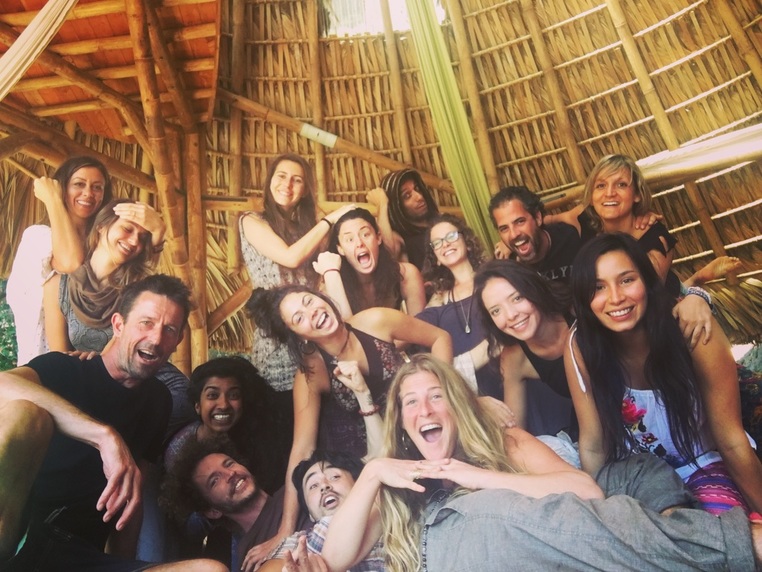5 Ways Thai Massage Complements Your Yoga Practice (For Practitioners & Teachers)
As I sit down to write about Thai Yoga Massage for our upcoming 300hr Training in Peru, I can not help but reflect on my most recent trip to Thailand and the similarities I continue to explore between the 2 healing arts, Yoga and Thai Massage. I find it difficult to talk about one without acknowledging the other.
By combining these practices I’ve enhanced my skills as a healer with greater awareness on the power of the energetic body and the stories our bodies hold physically. If we continue to do the work internally to unify with mind, body and spirit — Yoga — we will be able to maintain balance and health in the physical body — the ultimate goal of Thai Massage.
I always tell my students, in Yoga, we reach the energetic body through the physical asana practice but in Thai Massage we connect with the energetic body to release the physical body. Both practices are ancient healing arts that are still very much alive today. Although accessed through different modalities, the result is the same as it cultivates and nourishes peace in the mind, body, and soul.
Through my studies in Thailand, I have found many ways in which this practice complements yoga. For practitioners of yoga, giving or receiving Thai Massage can help you to release tension and discomfort in the body, have a deeper understanding of your own energetic body, and relax through therapeutic and dynamic movement and stretching. For a Yoga Teacher, learning Thai Massage can enhance your ability to see and feel the body in a whole new way, increase your ability to sequence intelligently, and assist you in making confident adjustments in your class.
Thai Massage is performed without any oil and with your clothes on. It starts at the feet, as they are a map to the entire body. Thai Massage blends elements of Acupressure, Yoga, Reflexology, Physiotherapy, Meditation, Energy Healing, Chiropractic and Ayurvedic wisdom.
Here are five ways Thai Massage relates to Yoga:
1. History
Both practices have their roots in India and are seen as a spiritual practice for healing mind, body and spirit. They are holistic therapies where the client is seen and treated as an ever-changing network of physical, mental, emotional and spiritual aspects that all influence each other. The primary aim is to restore and balance the body’s energy system.
2. Prayer
Traditionally, both practices start with an intention for healing and this intention provides a focal point for concentration as it leads into a meditative experience. When we offer a prayer in both practices, it is dedicated to the individual, the class, and usually to all beings on behalf of the individual’s practice. Om Mane Padme Hum is an example of a mantra used in both healing arts.
3. Breath
Breath is the primary focus in both Yoga and Thai Massage. The connection between the client and his own breath and the client to the practitioner’s breath help make the experience more fluid. Like Yoga, in Thai Massage the inhale and exhale happen through the nose.
4. Postures
This healing art is often called “Thai Yoga Massage” or “Lazy Man’s Yoga” because the positions the practitioner and the client take are yoga asanas. Some examples are Hero’s Pose, Upward Dog, Plank, Downward Dog, Low Lunge, Child’s Pose, Happy Baby, Supine and Seated Twists. The purpose is to move the spine in all directions throughout the session like any well-sequenced asana class.
5. Flow
Yoga and Thai Massage are like a dance and in order to flow need both rhythm and cadence. Ideally, through both practices the body and mind can fully surrender to giver and receiver so they are open to channel and receive the universal energy that exists all around.
Due to physical or emotional trauma, bad posture, injuries or limiting belief systems energy can get trapped or blocked, causing physical and emotional dis-ease. Thai Yoga Massage with its amazing multitude of techniques and adjustments can release these blockages and bring the body back to its natural equilibrium where perfect balance and well-being are present.
Thai Massage is a complementary and holistic practice alongside yoga, as it works all parts of oneself. If you are interested in advancing your awareness and practice by learning the skills of Thai Massage, please join me!
Randi’s open heart, affectionate manner and infectious laugh create an instant environment of friendship and authenticity. A true pollinator of people, her direct communication, sense of humor and energizing, activating manner allow for deep work to be done with a sense of playful acceptance for what is.
Randi ERYT 500 has taught over 50 yoga teacher trainings since 2010. Her expertise is in sharing Holistic Yoga, a well rounded practice including meditation, pranayama, mudra, bandha, mantra, theme weaving and intelligent sequencing. A certified Thai Massage Therapist, she is especially known for her firm and intuitive based hands on assists. She facilitates with a strong energy and passion for the practice which supports her compassionate, graceful and empathic nature. She has an innate ability to take in knowledge, experience it, and share wisdom in an authentic way.



